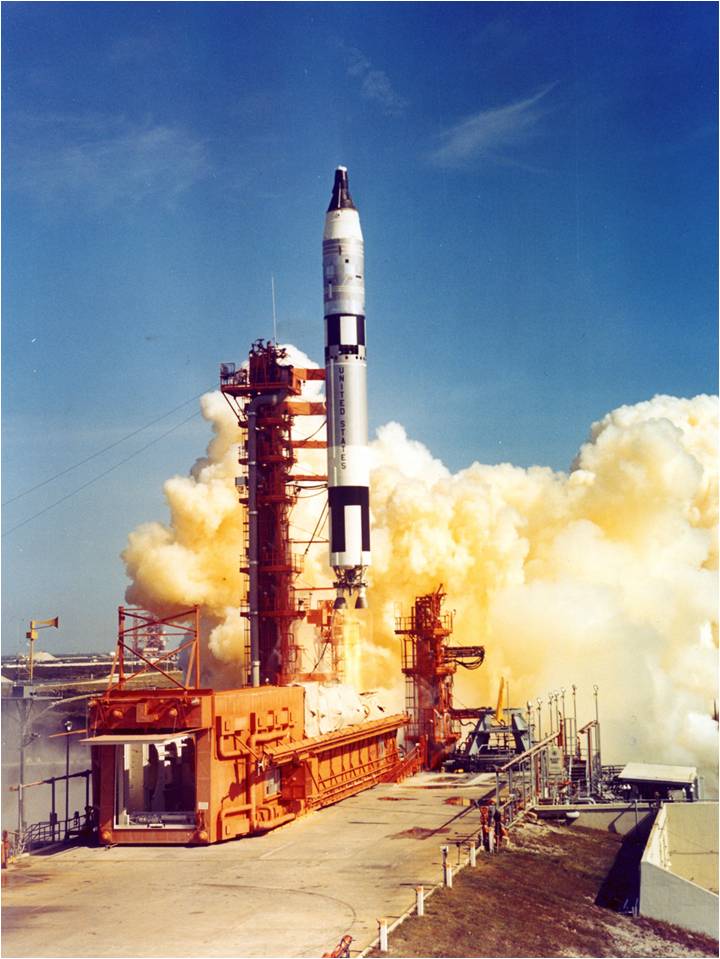
Forty-five years ago this month, NASA astronauts Leroy Gordon Cooper and Charles M. “Pete” Conrad set a new spaceflight endurance record during the flight of Gemini 5. It was the third of ten (10) missions in the historic Gemini spaceflight series. The motto for the mission was “Eight Days or Bust”.
The purpose of Project Gemini was to develop and flight-prove a myriad of technologies required to get to the Moon. Those technologies included spacecraft power systems, rendezvous and docking, orbital maneuvering, long duration spaceflight and extravehicular activity.
The Gemini spacecraft weighed 8,500 pounds at lift-off and measured 18.6 feet in length. Gemini consisted of a reentry module (RM), an adapter module (AM) and an equipment module (EM).
The crew occupied the RM which also contained navigation, communication, telemetry, electrical and reentry reaction control systems. The AM contained maneuver thrusters and the deboost rocket system. The EM included the spacecraft orbit attitude control thrusters and the fuel cell system. Both the AM and EM were used in orbit only and discarded prior to entry.
Gemini-Titan V (GT-5) lifted-off at 13:59:59 UTC from LC-19 at Cape Canaveral, Florida on Saturday, 21 August 1965. The two-stage Titan II launch vehicle placed Gemini 5 into a 189 nautical mile x 87 nautical mile elliptical orbit.
A primary purpose of the Gemini 5 mission was to stay in orbit at least eight (8) days. This was the minimum time it would take to fly to the Moon, land and return to the Earth. Other goals of the Gemini 5 mission were to test the first fuel cells, deploy and rendezvous with a special rendezvous pod and conduct a variety of medical experiments.
Despite fuel cell problems, electrical system anomalies, reaction control system issues and the cancellation of various experiments, Gemini 5 was able to meet the goal of an 8-day flight. But it wasn’t easy. The last days of the mission were especially demanding since the crew didn’t have much to do. Pete Conrad called his Gemini 5 experience “8 days in a garbage can.”
On Sunday, 29 August 1965, Gemini 5 splashed-down in the Atlantic Ocean at 12:55:13 UTC. Mission elapsed time was 7 days, 22 hours, 55 minutes and 13 seconds. A new spaceflight endurance record.
Gemini 5 was Gordon Cooper’s last spaceflight. Cooper left NASA due to a deteriorating relationship with management. Pete Conrad flew three (3) more times in space. In particular, he commanded the Gemini 11, Apollo 12 and Skylab I missions. Indeed, Conrad’s Apollo 12 experience made him the third man to walk on the Moon.
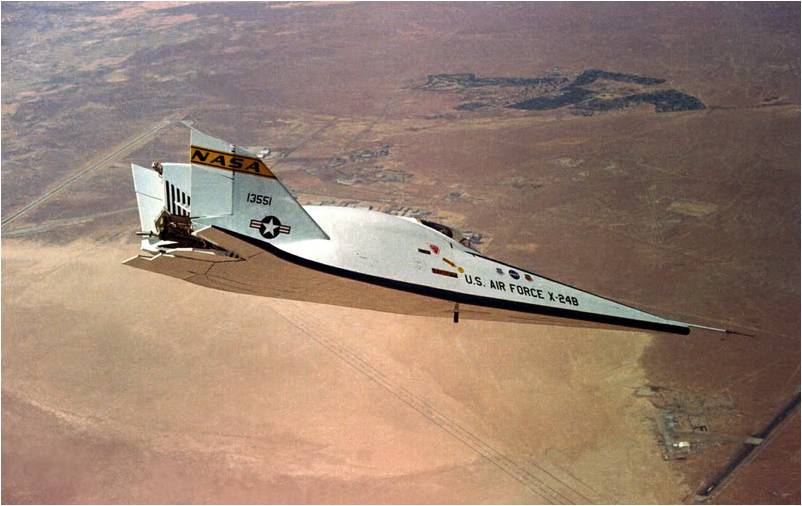
Thirty-five years ago this month, the USAF/NASA/Martin X-24B became the first lifting body to make an unpowered precision landing on a concrete runway. The feat was pivotal to convincing NASA officials that landing the Space Shuttle Orbiter in an unpowered state was operationally feasible.
Early Space Shuttle Orbiter operational concepts featured the use of a pair of turbojets to provide a powered landing capability. These engines were to be internally stowed just below the Orbital Maneuvering System (OMS) pods. They would be deployed and started once the Orbiter had decelerated to high subsonic speeds.
While airbreathing propulsion would give the Orbiter a loiter and go-around capability, the drawbacks were significant. Jet fuel would have to be carried into and out of orbit. The weight of this fuel and the turbojets would penalize Orbiter payload capability. The system would also increase complexity and cost to Shuttle operations.
As the Shuttle Program grappled with the development of a powered landing capability for the Orbiter, the NASA DFRC flight test community made what appeared to be a rather bold claim. The Orbiter could simply glide all the way to touchdown and land deadstick. After all, X-planes had been doing so safely and without incident since the late 1940’s.
A leading proponent of unpowered Shuttle landings was NASA DFRC test pilot John Manke. He was convinced that the Orbiter could routinely and safely conduct unpowered precision landings on a concrete runway. If true, the Orbiter could land anywhere a 15,000-foot concrete runway was located.
Manke proposed that the X-24B (S/N 66-13551) lifting body be employed to conduct unpowered precision landings on Runway 04/22 at Edwards Air Force Base. He and fellow test pilot USAF Lt. Col. Michael V. Love practiced low lift-to-drag precision landings using F-104 and T-38 aircraft in preparation for the demonstrations.
On Tuesday, 05 August 1975, John Manke successfully made the first-ever unpowered precision landing of an aircraft on a concrete runway. The X-24B main gear touched-down exactly at the aimpoint situated 5,000 feet down Runway 04/22. On Wednesday, 20 August 1975, Mike Love duplicated the feat.
Following the successful unpowered precision landings with the X-24B lifting body, John Manke was quoted as saying: “We now know that concrete runway landings are operationally feasible and that touchdown accuracies of ±500 feet can be expected.” NASA Space Shuttle Program management concurred and officially adopted the unpowered precision landing concept.
Nearly thirty years of Orbiter flight operations have confirmed the wisdom of that long-ago decision.
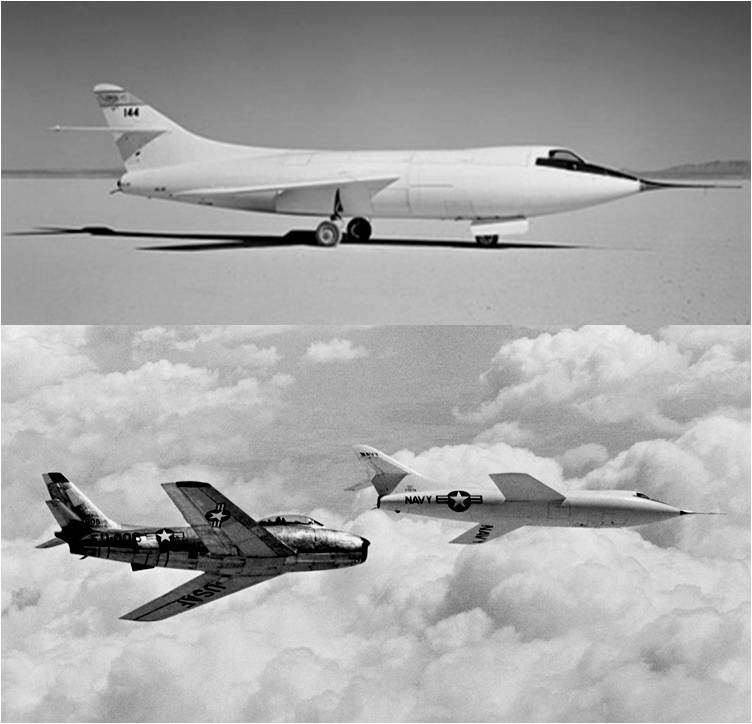
Fifty-seven years ago this week, the USN/Douglas D-558-II Skyrocket soared to an unofficial world record altitude of 83,235 feet. The Skyrocket’s record altitude mission was piloted by USMC test pilot and World War II triple-ace Lieutenant Colonel Marion E. Carl.
The D-558-II was a United States Navy (USN) X-aircraft and first flew in February of 1948. It was contemporaneous with the USAF/Bell XS-1. The aircraft measured 42 feet in length with a wing span of 25 feet. Maximum take-off weight was 15,266 pounds. Douglas manufactured a trio of D-558-II aircraft (Bureau No.’s 37973, 37974 and 37975).
The original version of the swept-wing D-558-II had both rocket and turbojet propulsion. The latter system provided a ground take-off capability. However, like other early X-aircraft such as the XS-1, X-1A, X-2 and X-15), the D-558-II achieved max performance through the use of a mothership and rocket power alone.
On Friday, 21 August 1953, D-558-II (Bureau No. 37974; NACA 144) was carried to a drop altitude of approximately 30,000 feet over Edwards Air Force Base by a USN P2B-1S launch aircraft. Following drop, Carl fired his LR-8 rocket motor and executed a pull-up in an effort to extract maximum altitude from the D-558-II. Carl hit a maximum Mach number of 1.728 and exceeded the existing altitude by about 3,800 feet.
Flying the D-558-II to altitudes beyond 65,000 feet required Carl to wear a full-pressure suit. The versions available to test pilots in the early 1950’s were crude by today’s standards. They were extremely uncomfortable and very confining. The pilot had to use reverse breathing to supply adequate oxygen to the lungs.
Reverse breathing involves the inhalation of air under pressure wherein oxygen is forced into the lungs by simply opening the mouth. One then has to make a conscious effort to exhale against that pressure in order rid the lungs of carbon dioxide. This unnatural breathing process had to be practiced by a pilot until it became second nature.
Flying the D-558-II (and other 1950’s high-speed research aircraft such as the X-1, X-1A and X-2) to extreme altitude was a sporty proposition. These aircraft exhibited disturbing lateral-directional control characteristics at low dynamic pressure. None of the early X-planes were configured with a 3-axis reaction control system. Control had to be maintained solely by aerodynamic means.
Marion Carl’s altitude mark in the D-558-II would stand until September of 1956 when USAF Captain Iven Kincheloe flew the USAF/Bell X-2 to an altitude of 126,000 feet. Today, the record-setting D-558-II (NACA 144) is displayed at the National Air and Space Museum in our Nation’s capital.
Marion Carl went on to serve his country until he retired from the Marine Corps in 1973 after having attained the rank of Major General. Sadly, Carl was shot to death in 1998 at the age of 82 as he defended his wife Edna from a home invader. A true American hero, Marion E. Carl was buried with full military honors at Arlington National Cemetery.
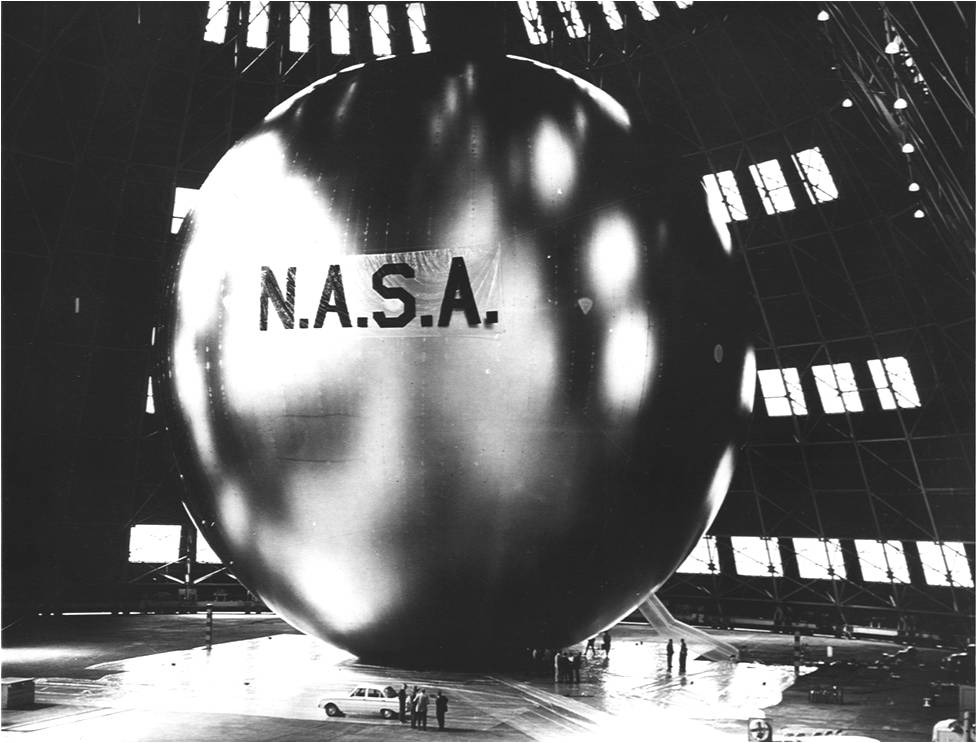
Fifty years ago this week, the United States successfully launched the Echo 1A passive communications satellite into Earth orbit. The 100-foot diameter balloon was among the largest objects ever to orbit the Earth.
A plethora of earth-orbiting communication satellites provide for a global connectivity that is commonplace today. Such was not always the case. Roll the clock back a half-century and we find that a global communications satellite system was just a concept. However, keen minds would soon go to work and provide mankind with yet another tangible spaceage benefit.
Communications satellites are basically of two types; passive and active. A passive communications satellite (PCS) simply reflects signals sent to it from a point on Earth to other points on the globe. An active communications satellite (ACS) can receive, store, modify and/or transmit Earth-based signals.
The earliest idea for a PCS involved the use of an orbiting spherical balloon. The balloon was fabricated from mylar polyester having a thickness of a mere 0.5 mil. The uninflated balloon was packed tightly into a small volume and inserted into a payload canister preparatory to launch. Once in orbit, the balloon was released and then inflated to a diameter of 100 feet.
The system described above materialized in the late 1950’s as Project Echo. The Project Echo satellite was essentially a huge spherical reflector for transcontinental and intercontinental telephone, radio and television signals. The satellite was configured with several transmitters for tracking and telemetry purposes. Power was provided by an array of nickel-cadmium batteries that were charged via solar cells.
Echo 1 was launched from Cape Canaveral, Florida on Friday, 13 May 1960. However, the launch vehicle failed and Echo 1 never achieved orbit. Echo 1A (sometimes referred to as Echo 1) lifted-off from Cape Canveral’s LC-17A at 0939 UTC on Friday, 12 August 1960. The Thor Delta launch vehicle successfully placed the 166-lb satellite into a 820-nm x 911-nm orbit.
An interesting characteristic of the Echo satellite was the large oscillation in the perigee of its orbit (485 nm to 811 nm) over several months. This was caused by the influences of solar radiation and variations in atmospheric density. While these factors are just part of the earth-orbital environment, their effects were much more noticeable for Echo due to the type’s large surface area-to-weight ratio.
Echo 1A orbited the Earth until it reentered the Earth’s atmosphere on Saturday, 25 May 1968. Echo 2 was a larger and improved version of Echo 1A. It measured 135-feet in diameter and weighed 547-lb. Echo 2 orbited the Earth between January of 1964 and June of 1969. Other than the Moon, both satellites were the brightest objects observable in the night sky due to their high reflectivity.
The Echo satellites served their function admirably. For a time, they were quite a novelty. However, progress on the ACS scene quickly relegated the PCS to obselescence. Today, virtually all communication satellites are of the ACS variety.
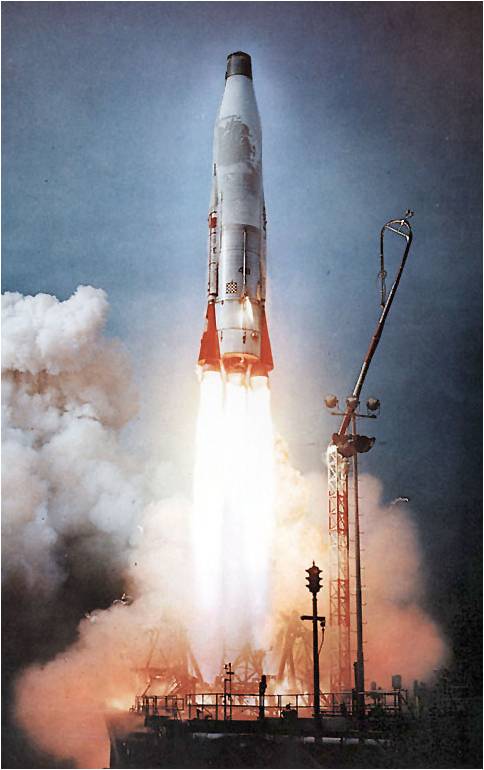
Fifty-two years ago today, an Atlas B flew 2,500 miles down the Eastern Test Range in a key developmental test of America’s first Intercontinental Ballistic Missile (ICBM). Among other historic achievements, the test marked the first successful flight of the innovative stage-and-a-half missile.
The infamous Cold War between the United States and the Soviet Union was marked by the specter of nuclear confrontation. Each side developed a family of launch vehicles that could deliver nuclear ordnance to the homeland of the other. The type of launch vehicle employed is known as an Intercontinental Ballistic Missile (ICBM).
An ICBM flies a long, arcing (sub-orbital) trajectory to the target. This flight path is parabolic in shape and thousands of miles in range. The maximum altitude point (apogee) is about mid-way to the target and is located hundreds of miles above the surface of the Earth. An ICBM can reach any point on the globe within 30 minutes of launch.
The first ICBM developed by the United States was the Atlas missile. The origins of this program date back to late 1945 when the United States Army requested proposals from the aerospace industry for novel long-range missile concepts. Consolidated-Vultee Aircraft (Convair) caught the Army’s eye with a missile design that ultimately became the Atlas.
The Atlas was innovative from a number of standpoints. Perhaps most novel was the use of very thin stainless steel tankage in an effort to provide the Atlas with an extremely lightweight structure. However, the tank was so thin that a screwdriver could easily puncture its walls. Moreover, the tank would collapse even under its own weight. Nitrogen pressurization was employed to obtain the necessary structural rigidity.
Another Atlas innovation involved the use of the so-called stage-and-a-half or parallel staging propulsion concept. This system was comprised of a pair of outboard boosters (Stage 0) and a single sustainer core (Stage 1). These engines burned a LOX/kerosene propellant mix and were ignited at launch. Stage 0 was jettisoned after 135 seconds of flight. The sustainer continued to fire an additional 95 seconds.
Atlas A was first flown in June of 1957. The type operated the booster engines only and carried a mass simulator warhead. Only three (3) of its eight (8) developmental flight tests were considered successful. The type achieved a maximum range of 600 nm during its third flight which occurred on Tuesday, 17 December 1957.
Atlas B was the first Atlas test vehicle to operate both the booster and sustainer rocket engines. The vehicle measured 85 feet in length and had a diameter of 10 feet. Lift-off weight was slightly over 244,000 pounds. Its XLR89-5 booster engines and XLR105-5 sustainer engine generated 341,130 and 81,655 pounds of vacuum thrust, respectively.
Atlas B test vehicles flew ten (10) times and enjoyed seven (7) successful flight tests. The first launch (Atlas B, Serial No. 3B) occurred on Friday, 19 July 1958 and was not successful. Atlas B, Serial No. 4B lifted-off from Cape Canaveral’s LC-13 at 22:16 UTC on Saturday, 02 August 1958. This test was entirely successful as the missile reached an apogee of 560 miles and traveled 2,500 miles downrange.
In the years that followed, other Atlas variants were developed including the Atlas C, D, E, F, G and H. Atlas C was the first pre-production version of the Atlas Program. Atlas D was the first operational version of the Atlas ICBM. Atlas E and Atlas F missiles were the first ICBM’s stored in underground silos and raised to ground level for launch. Atlas G and H launched numerous space exploration payloads.
Ironically, the Atlas did not serve long in its primary role as an ICBM. The type was quickly eclipsed by more capable launch vehicles such as the Titan II. However, the Atlas would be used to great effect as a launch vehicle for a wide variety of satellites and scientific spacecraft. The Atlas was ultimately man-rated as a booster. It was used to successfully orbit Mercury astronauts during four (4) Mercury missions flown in 1962 and 1963.
The Atlas has continued to evolve as a commercial launch platform to the current day. The Atlas I was introduced in July of 1990. It was followed by the Atlas II and Atlas III in 1991 and 2000, respectively. The Atlas V is the most recent Atlas variant and first flew in 2002. Significantly, the Atlas is the longest running launch vehicle program in the history of American spaceflight.






